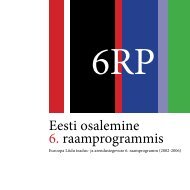Reactive Systems: Modelling, Specification and Verification - Cs.ioc.ee
Reactive Systems: Modelling, Specification and Verification - Cs.ioc.ee
Reactive Systems: Modelling, Specification and Verification - Cs.ioc.ee
You also want an ePaper? Increase the reach of your titles
YUMPU automatically turns print PDFs into web optimized ePapers that Google loves.
6.2. SYNTAX AND SEMANTICS OF HML WITH RECURSION 123<br />
p1<br />
a<br />
<br />
<br />
<br />
a<br />
<br />
b<br />
<br />
<br />
<br />
p2 <br />
p3<br />
a<br />
Figure 6.2: A process<br />
Example 6.2 Consider the formula F = 〈a〉X <strong>and</strong> let Proc be the set of states<br />
in the transition graph in Figure 6.2. If X is satisfied by p1, then 〈a〉X will be<br />
satisfied by p3, i.e., we expect that<br />
O 〈a〉X({p1}) = {p3} .<br />
If the set of states satisfying X is {p1, p2} then 〈a〉X will be satisfied by {p1, p3}.<br />
Therefore we expect to have that<br />
O 〈a〉X ({p1, p2}) = {p1, p3} .<br />
What is the set O [b]X({p2})? <br />
The above intuition is captured formally in the following definition.<br />
Definition 6.1 Let (Proc, Act, { a → | a ∈ Act}) be a labelled transition system.<br />
For each S ⊆ Proc <strong>and</strong> formula F , we define OF (S) inductively as follows:<br />
OX(S) = S<br />
Ott(S) = Proc<br />
Off(S) = ∅<br />
OF1∧F2 (S) = OF1 (S) ∩ OF2 (S)<br />
OF1∨F2 (S) = OF1 (S) ∪ OF2 (S)<br />
O 〈a〉F (S) = 〈·a·〉OF (S)<br />
O [a]F (S) = [·a·]OF (S) .<br />
A few words of explanation for the above definition are in order here. Intuitively,<br />
the first equality in Definition 6.1 expresses the trivial observation that if we assume<br />
that S is the set of states that satisfy X, then the set of states satisfying X is S!
















